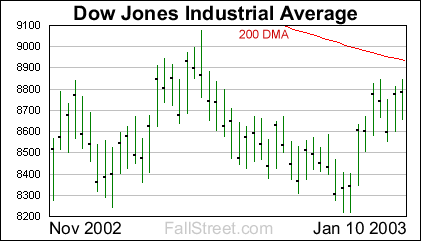January 13, 2003
World Watches as U.S. Markets Race to Resistance

Following the worst December since 1931, the U.S. markets have entered 2003 on a strong note. In fact, with the exception of the Brazilian exchange, the Bovespa, the U.S. markets have been the strongest in the world: with both the S&P 500 and Dow up more than 5% and the Nasdaq up 8.4%.
It is difficult to quantify why the U.S. markets have rallied so strongly to begin the year. Yes, the ‘experts have been chanting equities’ and the media has been paying homage to the ‘January Effect’. However, during the first two weeks of 2003 (7 trading session) some potentially ominous economic reports have been released, including last weeks 101K decline in payrolls (Dec) and a $2.2 billion decline in consumer credit (Nov). Do not these reports suggest that the U.S. jobs market is still weak and that the U.S. consumer, for the first time since the last recession, is changing their borrowing habits even as the Fed has hacked rates lower?
By contrast, only one report, December’s ISM Manufacturing Index, has beaten estimates so soundly as to suggest a new economic uptrend is emerging. As for the ISM report, one would think that a reported 29th straight decline in manufacturing employment would trump any speculation of a (ISM manufacturing) turnaround. However, as the CNN chart below and last Friday’s rally show, market reaction to jobs news has not always been what has been expected.
 |
What is especially troubling about analysis on the markets is that most are quick to point to Bush’s plan as fuel for the markets. Think about it: momentum based and dividendless tech stocks would benefit the least with Bush’s plan so they deserve to rally the most?
Suffice it to say, it is impossible to pin down the exact reason(s) why the U.S. markets are leading the world. Rather, what we do know is that Wall Street expects a stronger recovery leading into the second half of 2003, 4Q02 earnings will be up 10+% compared to a pathetic 4Q01, underfunded pension funds are being handed some extra funds to play with, the bond market may be unattractive to many investors, Bush will eventually pass some type of stimulus package, and the Iraq war has not started. These seem to be the flurry of less than fantastic reasons why the markets are rallying…These appear to be the reasons why a 101,000 drop in December payrolls can be regarded as a non event for stocks.
Moving Averages Moving In
Dependent on whether or not you believe this is a new bull market or bear market rally, the major U.S. markets are either close to breaking out or close to serious resistance. The levels to keep in mind are not only the markets previous ‘highs’ but each average’s 200 Day Moving Average (one of the most basic and powerful bull/bear market indicators). If these levels, and I apologize for using Acampora logic here, are broken with authority a lot of market participants will be on the wrong side of the markets – which could potentially fuel further gains. As strange as it may sound, many investors would rather be buyers of U.S. stocks when these levels are broken to the upside and not before.
As for the Dow, with its 200 DMA now within single session firing range, and its previous top being actually higher than its 200 DMA, the potential for a sharp rally (200 DMA cheerleading) exists without the potential for a ‘new highs’ rally. The Nasdaq is the only major average trading above its 200 DMA.
 |
|
The Week Ahead
On January 2, 2002 the NAPM Index (now the ISM Index) beat estimates (48.2 versus 46 est.) and this helped fuel a brief rally. And although the January 2002 rally topped out quickly, 10,345.40 on January 7, a spackle of economic reports began surprising to the upside in early January, or well before the markets responded by rallying in late February/March. Point being, watching the forward looking reports this week, which include the Philadelphia Fed, Mich. Consumer Confidence, and possibly weekly jobless claims, may be more important than focusing on retail sales and Industrial production (main reports due out this week.) Incidentally, on January 17,18, 2002 both the Philadelphia Fed and Mich. Confidence reports beat estimates by a large margin (14.7 versus estimates of -2.5 for PF and 94.2 versus estimates of 90 for MC.) Will 2003 be a case of déjà vu?
|
As Corporate America begins to release 4Q02 earnings results the markets all the major U.S. markets are near key technical levels. Whether or not these levels serve as resistance or support for stocks may not be decided on the EPS results themselves, but the perception that earnings will improve in the future. To be sure, beating 4Q01 EPS results is nothing for investors to cheer about. Rather, since many companies have already taken steps to cut costs, including laying off workers and reducing capex programs, beating bottom line 4Q01 results has been made easy.
As investors begin rewarding and punishing companies for their EPS gains/losses remember that year-over-year revenue gains will be only half as strong as EPS gains. Corporate America is becoming more efficient and more cautious, which is reflected in EPS, but most companies are not seeing a noticeable uptick in business.
|
|
All data and information within these pages is thought to be taken from reliable sources but there is no guarantee as such. All opinions expressed on this site are opinions and should not be regarded as investment advice.
Copyright © 2000, 2001, 2002
FallStreet.com